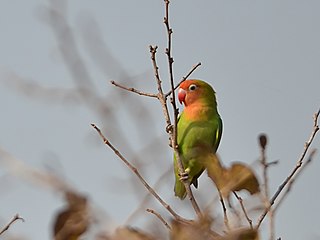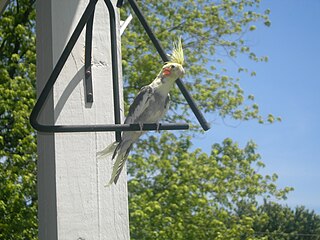
The lutino peach-faced love bird (Agapornis roseicollis) is one of the most popular mutations of rosy-faced lovebird. It is closely followed by the Dutch blue lovebird in popularity. [1]

The lutino peach-faced love bird (Agapornis roseicollis) is one of the most popular mutations of rosy-faced lovebird. It is closely followed by the Dutch blue lovebird in popularity. [1]

Lovebird is the common name for the genus Agapornis, a small group of parrots in the Old World parrot family Psittaculidae. Of the nine species in the genus, all are native to the African continent, with the grey-headed lovebird being native to the African island of Madagascar.

The cockatiel, also known as the weero/weiro or quarrion, is a medium-sized parrot that is a member of its own branch of the cockatoo family endemic to Australia. They are prized as household pets and companion parrots throughout the world and are relatively easy to breed. As a caged bird, cockatiels are second in popularity only to the budgerigar.

The rosy-faced lovebird, also known as the rosy-collared or peach-faced lovebird, is a species of lovebird native to arid regions in southwestern Africa such as the Namib Desert. Loud and constant chirpers, these birds are very social animals and often congregate in small groups in the wild. They eat throughout the day and take frequent baths. Coloration can vary widely among populations. Plumage is identical in males and females. Lovebirds are renowned for their sleep position in which they sit side-by-side and turn their faces in towards each other. Also, females are well noted to tear raw materials into long strips, "twisty-tie" them onto their backs, and fly substantial distances back to make a nest. These birds are common in the pet industry.

Lilian's lovebird, also known as the Nyasa lovebird, is a small African parrot species of the lovebird genus. It is mainly green and has orange on its upper chest and head. It is 13 cm (5 inches) long and is the smallest parrot on mainland Africa. In captivity, it is uncommon and difficult to breed.

Fischer's lovebird is a small parrot species of the genus Agapornis. They were originally discovered in the late 19th century. They are named after German explorer Gustav Fischer.

The science of budgerigar color genetics deals with the heredity of mutations which cause color variation in the feathers of the species known scientifically as Melopsittacus undulatus. Birds of this species are commonly known by the terms 'budgerigar', or informally just 'budgie'.

The yellow-collared lovebird, also called masked lovebird, black-masked lovebird or eye ring lovebird, is a monotypic species of bird of the lovebird genus in the parrot family Psittaculidae. They are native to Arusha Region of Tanzania and have been introduced to Burundi and Kenya. Although they have been observed in the wild in Puerto Rico, they are probably the result of escaped pets, and no reproduction has been recorded. They have also been observed in Arizona.
Lutino is a bird that exhibits a yellow pigmentation known as xanthochromism. It may refer to:

The science of rosy-faced lovebird colour genetics deals with the heredity of colour variation in the feathers of the species known as Agapornis roseicollis, commonly known as the rosy-faced lovebird or peach-faced lovebird.

The science of cockatiel colour genetics deals with the heredity of colour variation in the feathers of cockatiels, Nymphicus hollandicus. Colour mutations are a natural but very rare phenomenon that occur in either captivity or the wild. About fifteen primary colour mutations have been established in the species which enable the production of many different combinations. Note that this article is heavily based on the captive or companion cockatiel rather than the wild cockatiel species.

The Blue budgerigar mutation is one of approximately 30 mutations affecting the colour of budgerigars. It is part of the genetic constitution of the following recognised varieties: Skyblue, Cobalt, Mauve and Violet.
The Ino budgerigar mutation is one of approximately 30 mutations affecting the colour of budgerigars. It is the underlying mutation of the Albino and Lutino varieties and, with Cinnamon, a constituent mutation of the Lacewing variety.
The red-suffusion rose-faced lovebird, also known as the red-pied lovebird, is not a true colour mutation of lovebird species. Many breeders believe it is due to a health issue, most likely dealing with the bird's liver. Some think the red-pied has some genetic relations with the Lutino rosy-faced lovebird mutation, as many cases of red spots appear in Lutino lovebirds. Although many breeders of parrots have claimed that this is a genetic mutation, no one has been able to successfully reproduce it through a series of generations.

A hybrid lovebird is the result of two species of lovebirds being cross-bred. Hybrids produced by the pairing of a rosy-faced lovebird with one of the "eye-ring" species are usually sterile, whereas crosses between the "eye-ring" species are often fertile.

The lutino cockatiel is one of the most popular mutations of cockatiel, with white to light-yellow feathers and orange/red cheek patches.

The Pied cockatiel is the first mutation of cockatiel colour genetics, with a mostly grey to light-yellow and white feathers and orange cheek patches.

The normal grey cockatiel, wild type cockatiel, wild cockatiel or grey cockatiel, is the origin cockatiel of all colour genetics mutations, with mostly grey feathers and orange cheek patches.

The white-faced cockatiel is one of the cockatiel colour genetic mutations, with a mostly white or grayish face. They stand out because they have no orange cheek patches or yellow coloring at all. This is the seventh established mutation which appeared for the first time with domesticated cockatiels in 1964 in Holland.

Dirk Van den Abeele is a Flemish ornithologist, specializing in the genus Agapornis. He has written a number of books on this subject. Most of his books have been translated into English, Greek, Spanish, French, Czech, Italian and German. Since 1999, Van den Abeele is a member of MUTAVI, Research & Advice Group in The Netherlands, where he is conducting research, together with Inte Onsman, into pigmentation of the various colour mutations in birds. Together with the Australian veterinarian Terry Martin he collaborated on the 'International Agreements for Naming Colour Mutations in Psittaciformes'. He was chairman of BVA International, the Belgian Lovebird Society from 1999 till December 2010. Since 2011 he is honorary chairman of BVA-International.
Bronze Fallow Cockatiel is a kind of cockatiel with glowing red eyes. It is first seen in the bird house which belongs to Mrs. Irma Vowels.in Florida, the USA. It is also known as fallow.